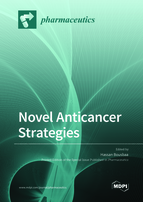Novel Anticancer Strategies
A special issue of Pharmaceutics (ISSN 1999-4923). This special issue belongs to the section "Clinical Pharmaceutics".
Deadline for manuscript submissions: closed (30 September 2020) | Viewed by 57821
Special Issue Editor
Interests: targeted anticancer therapy; targeting mitosis for cancer therapy; antimitotic agents; biological evaluation of natural and synthetic compounds; cancer biomarkers
Special Issues, Collections and Topics in MDPI journals
Special Issue Information
Dear Colleagues,
The clinical efficacy of the available cancer therapies has been impaired by serious side effects and drug resistance. Cancer incidence and mortality continue to increase rapidly worldwide. Therefore, the development and discovery of novel therapeutic strategies are urgently needed in order to overcome the drawbacks associated with the strategies in use in the clinic, and to offer more effective therapeutic options. Novel cancer treatment strategies are being developed to selectively detect and eradicate malignant cells, with minimal damage to the healthy tissue, contrasted with conventional strategies.
In this Special Issue of Pharmaceutics, novel anticancer strategies with reduced toxicity and improved therapeutic indices, presented in original articles and comprehensive reviews highlighting the latest advances, are welcome. These strategies would suggest prospects for optimizing cancer therapies, hopefully with tremendous clinical value in the near future. Towards these aims, we encourage submissions that focus on the development and validation of novel anticancer approaches, which include, but are not limited to, ligand-/receptor-based targeting, controlled drug delivery, gene delivery, targeted anticancer prodrug and conjugate (photoactivatable caged prodrugs, ADEPT, ADAPT, ADCs), magnetic and ultrasound-mediated drug targeting, and cancer stem cell therapy that explores the targeting of signaling cascades and the tumor microenvironment.
Dr. Hassan Bousbaa
Guest Editor
Manuscript Submission Information
Manuscripts should be submitted online at www.mdpi.com by registering and logging in to this website. Once you are registered, click here to go to the submission form. Manuscripts can be submitted until the deadline. All submissions that pass pre-check are peer-reviewed. Accepted papers will be published continuously in the journal (as soon as accepted) and will be listed together on the special issue website. Research articles, review articles as well as short communications are invited. For planned papers, a title and short abstract (about 100 words) can be sent to the Editorial Office for announcement on this website.
Submitted manuscripts should not have been published previously, nor be under consideration for publication elsewhere (except conference proceedings papers). All manuscripts are thoroughly refereed through a single-blind peer-review process. A guide for authors and other relevant information for submission of manuscripts is available on the Instructions for Authors page. Pharmaceutics is an international peer-reviewed open access monthly journal published by MDPI.
Please visit the Instructions for Authors page before submitting a manuscript. The Article Processing Charge (APC) for publication in this open access journal is 2900 CHF (Swiss Francs). Submitted papers should be well formatted and use good English. Authors may use MDPI's English editing service prior to publication or during author revisions.
Keywords
- Cancer therapy
- Drug delivery
- Drug carriers
- Targeted therapy
- Prodrugs (photoactivatable caged prodrugs, ADEPT, and ADAPT)
- Antibody drug-conjugates (ADCs)
- Controlled drug release
- Immunotherapy
- Gene therapy (GDEPT)
- Stem cell therapy
Related Special Issues
- Novel Anticancer Strategies (Volume II) in Pharmaceutics (33 articles)
- Novel Anticancer Strategies (Volume III) in Pharmaceutics (20 articles)







